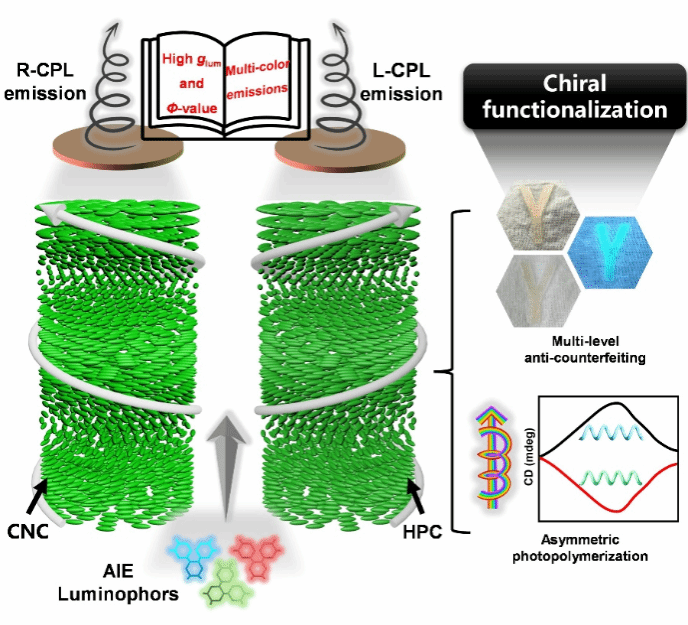Recently, Dr. Zhang Fusheng from the “Intelligent Polymer Interface Materials” research team at our School of Chemistry and Chemical Engineering developed a chiral fluorescent composite film exhibiting strong left-handed circularly polarized luminescence (L-CPL). This breakthrough fills a long-standing gap in which nanocellulose derivatives only exhibited right-handed circularly polarized luminescence (R-CPL), laying a foundation for the study of asymmetry in chiral circularly polarized light from nanocellulose.

The interaction between circularly polarized luminescence and materials provides opportunities for the development of various emerging technologies, such as quantum computing and information encryption, 3D naked-eye displays, asymmetric catalysis, chiral sensing, and imaging of chiral biomolecules. Achieving both a large asymmetry factor (glum) and high quantum yield (Φ) in circularly polarized luminescent materials is essential for realizing these applications. Research on the self-assembly of cellulose nanocrystals (CNC) with liquid crystal phases and strong fluorescent components offers solutions to this challenge. However, traditional CNC systems only produce R-CPL and lack L-CPL, significantly limiting applications in chiral functionalization.
Our team proposed a strategy for co-assembling hydroxypropyl cellulose with aggregation-induced luminophores to construct L-CPL, achieving a large glum (+0.51) and high Φ (55.8%) in chiral fluorescent films. Additionally, these films exhibit comprehensive properties such as flexibility, solvent resistance, tunable structural colors, and multicolor L-CPL. They can serve as durable and multimodal optical anti-counterfeiting labels printed on fabrics, maintaining optical stability even after repeated washing and drying. Moreover, they can act as chiral light sources to induce asymmetric photopolymerization reactions with opposite L-CPL/R-CPL. This work will promote the application of nanocellulose chiral optical materials in circularly polarized 3D displays, chiral molecular sensing, and CPL imaging.
Our team has long been dedicated to the research of chiral functionalization of nanocellulose, and this study is a continuation of previous work: multimodal, convertible chiral optical anti-counterfeiting films (Adv. Funct. Mater. 2022 https://doi.org/10.1002/adfm.202204487); flexible sweat sensors using photonic cellulose nanocrystals (Small 2023 https://doi.org/10.1002/smll.202207932; Mater. Horiz. 2025 https://doi.org/10.1039/D4MH01148A).
The relevant research findings were recently published in Advanced Materials under the title “Intense Left-handed Circularly Polarized Luminescence in Chiral Nematic Hydroxypropyl Cellulose Composite Films”. The first author of this work is Huang Yuxiao, a master's student from the class of 2021 (now graduated), and the corresponding authors are Dr. Zhang Fusheng from our school and Researcher Qing Guangyan from the Dalian Institute of Chemical Physics, Chinese Academy of Sciences. This work was supported by the Doctoral Research Startup Fund of Wuhan Textile University and the National Natural Science Foundation of China. (Text/Image: Zhang Fusheng)
Article link: https://doi.org/10.1002/adma.202308742

